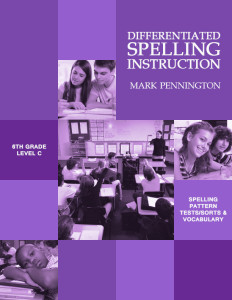How to Use the Spelling Pretest
The Monday spelling pretest: it’s as American as apple pie. Each of my three sons routinely scored 20/20 on the Monday spelling pretest. They were required to “study” and “practice” these words with an obligatory worksheet, crossword puzzle, or write-the-word-ten-times assignment. They were then tested on these same words on Friday. They learned zilch about spelling from this instructional practice.
The first task of an informed teacher is to determine what students already know and don’t know. The second task of an
informed teacher is to make use of the diagnostic data to differentiate and individualize instruction.
Here’s how to make sense of the spelling pretest and teach according to the results: Simply follow these five steps:
How to Use the Spelling Pretest
1. Prepare
Create Supplemental Spelling Lists for each student.
A. First, administer a comprehensive diagnostic spelling assessment to determine individual mastery and gaps. (Avoid qualitative inventories which do not clearly identify spelling patterns.) Grade the assessment and print grade-level resource words for each of the spelling pattern gaps.
B. Second, find and print these resources: For remedial spellers−Outlaw Words, Most Often Misspelled Words, Commonly Confused Words. And these: For grade level and accelerated spellers−Greek and Latinate spellings, Tier 2 words used in your current instructional unit. Of course, my curriculum referenced at the end of the article includes these resources.
C. Third, have your students set up spelling notebooks to record the spelling words which they, their parents, or you have corrected in their daily writing.
Now you’re ready to teach.
2. Pretest
Dictate the 15—20 words in the traditional word-sentence-word format to all of your students on Monday. Of course, the words do matter. Rather than selecting unrelated theme words such as colors, holidays, or the like, choose a spelling program which organizes instruction by specific spelling patterns. Here’s a nice CCSS L.2 Grades 4-8 Spelling Scope and Sequence for spelling.
Have students self-correct from teacher dictation of letters in syllable chunks, marking dots below the correct letters, and marking an “X” through the numbers of any spelling errors. This is an instructional activity that can be performed by second graders. Don’t rob your students of this learning activity by correcting the pretest yourself.
3. Personalize
Students complete their own 15−20 word Personal Spelling List in the following order of priority:
• Pretest Errors: Have the students copy up to ten of their pretest spelling errors onto a Personal Spelling List. Ten words are certainly enough to practice the grade-level spelling pattern.
• Last Week’s Posttest Errors: Have students add up to three spelling errors from last week’s spelling posttest.
• Writing Errors: Have students add up to three student, parent, or teacher-corrected spelling errors found in student writing.
• Spelling Pattern Errors: Have students add on up to three words from one spelling pattern deficit as indicated by the comprehensive diagnostic spelling assessment. Of course, my curriculum referenced at the end of the article includes these resources: Spelling Pattern Worksheets with the spelling pattern/rule clearly explained, example words, spelling sorts, rhymes, word jumbles, writing application, and a short formative assessment.
• Supplemental Spelling Lists: Students select words from these resources to complete the list.
4. Practice
Have students practice their own Personal Spelling Words list.
A. Use direct instruction and example words to demonstrate the weekly spelling pattern.
B. Have students create their own spelling sorts from their Personal Spelling List.
C. Provide class time for paired practice. Spelling is primarily an auditory process.
5. Posttest
On Friday (or why not test every two weeks for older students?) tell students to take out a piece of binder paper and find a partner to exchange dictation of their Personal Spelling List words. Now, this makes instructional sense—actually using the posttest to measure what students have learned! But, you may be thinking…what if they cheat? For the few who cheat…It would be a shame to not differentiate instruction for the many to cater to a few. Truly, they are only cheating themselves.
*****
I’m Mark Pennington, author of the full-year Differentiated Spelling Instruction for grades 4, 5, 6, 7, and 8.
Or why not get the value-priced Grammar, Mechanics, Spelling, and Vocabulary (Teaching the Language Strand) grades 4, 5, 6, 7, and 8 BUNDLES? These grade-level programs include both teacher’s guide and student workbooks and are designed to help you teach all the Common Core Anchor Standards for Language. In addition to the Teaching Grammar and Mechanics program, each BUNDLE provides weekly spelling pattern tests and accompanying spelling sort worksheets (L.2), 56 language application opener worksheets (L.3), and 56 vocabulary worksheets with multiple-meaning words, Greek and Latin word parts, figures of speech, word relationships with context clue practice, connotations, and four square academic language practice (L.4, 5, and 6). Comprehensive biweekly unit tests measure recognition, understanding, and application of the grammar, mechanics, and vocabulary components.
The program also has the resources to meet the needs of diverse learners. Diagnostic grammar, usage, mechanics, and spelling assessments provide the data to enable teachers to individualize instruction with targeted worksheets. Each remedial worksheet (over 200 per program) includes independent practice and a brief formative assessment.
Check out the brief introductory video and enter DISCOUNT CODE 3716 at check-out for 10% off this value-priced program. We do sell print versions of the teacher’s guide and student workbooks. Contact mark@penningtonpublishing.com for pricing. Read what teachers are saying about this comprehensive program:
The most comprehensive and easy to teach grammar, mechanics, spelling, and vocabulary program. I’m teaching all of the grade-level standards and remediating previous grade-level standards. The no-prep and minimal correction design of this program really respects a teacher’s time. At last, I’m teaching an integrated program–not a hodge-podge collection of DOL grammar, spelling and vocabulary lists, and assorted worksheets. I see measurable progress with both my grade-level and intervention students. BTW… I love the scripted lessons!
─Julie Villenueve


